Feature: Reclaiming indigenous history from Amazonian soil
26 May 2023
UCL archaeologist Dr Manuel Arroyo-Kalin has been working with Brazilian researchers and indigenous peoples to help better understand and share their cultural heritage.
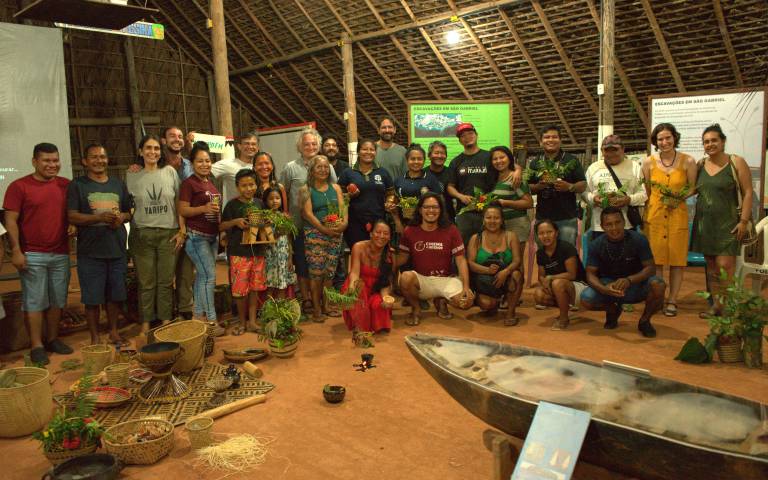
Along the banks of the Rio Negro in northwest Brazil, there lies the largest untouched rainforest tract in the whole of the Amazon basin, demarcated as an indigenous territory.
Archaeologists, anthropologists, and other scholars, as well as indigenous peoples themselves, know that the region was inhabited in pre-colonial times. Yet archaeological knowledge about the details remains scarce.
Since 2019, thanks to a British Academy/Global Challenges Research Fund grant in Sustainable Development, UCL archaeologist Dr Manuel Arroyo-Kalin has led an exciting interdisciplinary project there. It seeks to uncover evidence of age-old human occupations, as well as developing intercultural dialogue with local indigenous communities.
Partnering with researchers from Brazilian museums - Museu da Amazônia (Musa) and Museu Paraense Emílio Goeldi (MPEG) - as well as São Carlos Federal University (UFSCar) and NGO Instituto Socioambiental (ISA), the Intercultural Archaeology Programme of the Northwest Amazon (PARINÃ) took shape. It is a long-term research strategy that aims to study the history of the north-west Amazon through intercultural engagement with the people living there.
PARINÃ archaeologists helped to train the region’s first indigenous archaeology students, involving them in archaeological excavations uncovering artefacts that could be up to 2,000 years old.
In February 2023 the team presented initial results of these excavations, alongside other project outputs, in an exhibition in São Gabriel da Cachoeira. This small municipality in the Brazilian state of Amazonas is widely known as “Brazil’s most indigenous town”, due to its location within a territory inhabited by more than 25 different indigenous groups, each with its own language. The exhibition, entitled Memories of Ancestral Landscapes and curated by Musa, aimed to return to the community the results of recent research, even if in its early stages, in an accessible and meaningful way, with a view to promoting discussion about the relevance of cultural heritage.
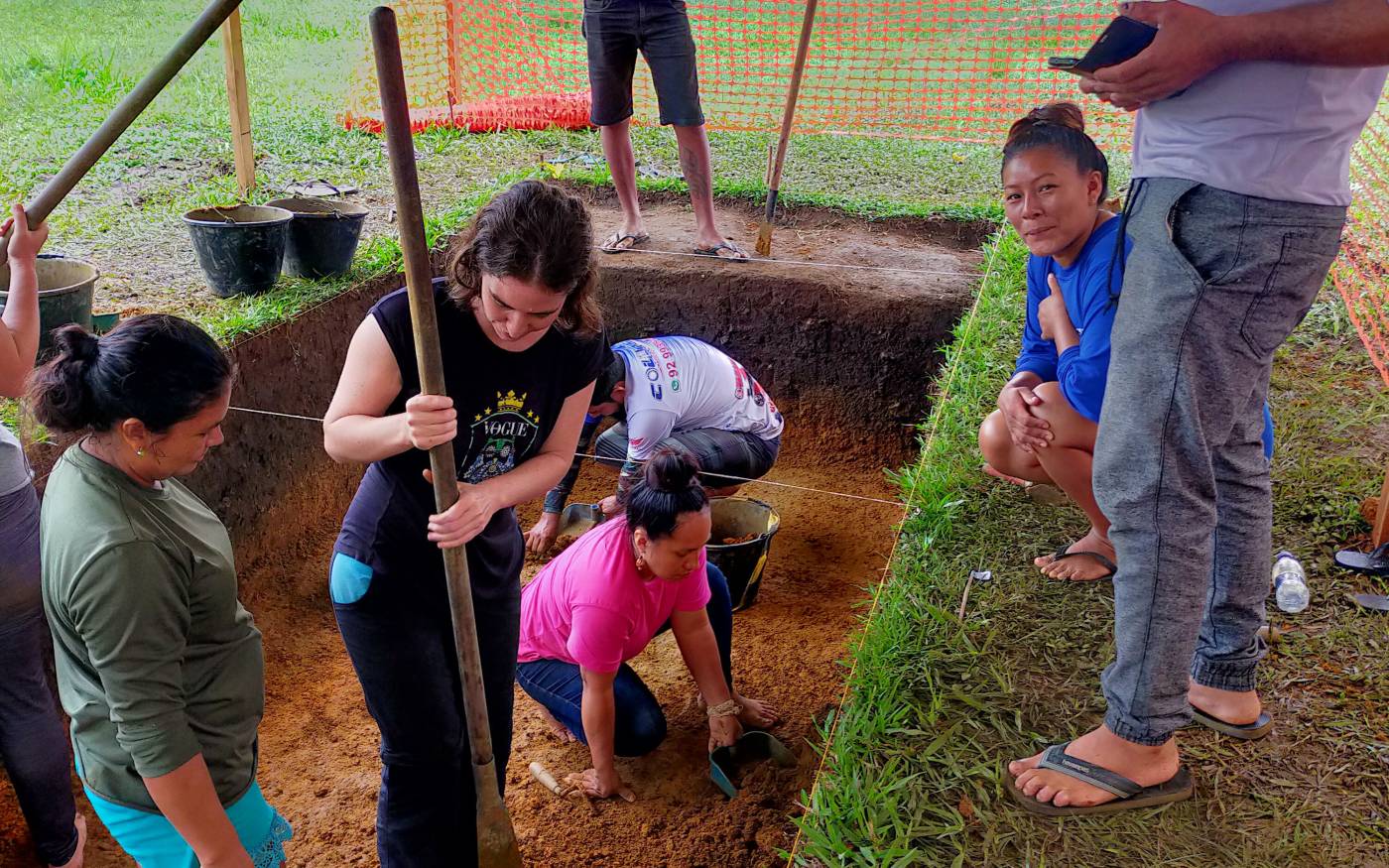
Dr Meliam Gaspar (MUSA) and student archaeologists excavate artefacts as part of the PARINÃ programme in the Amazon.
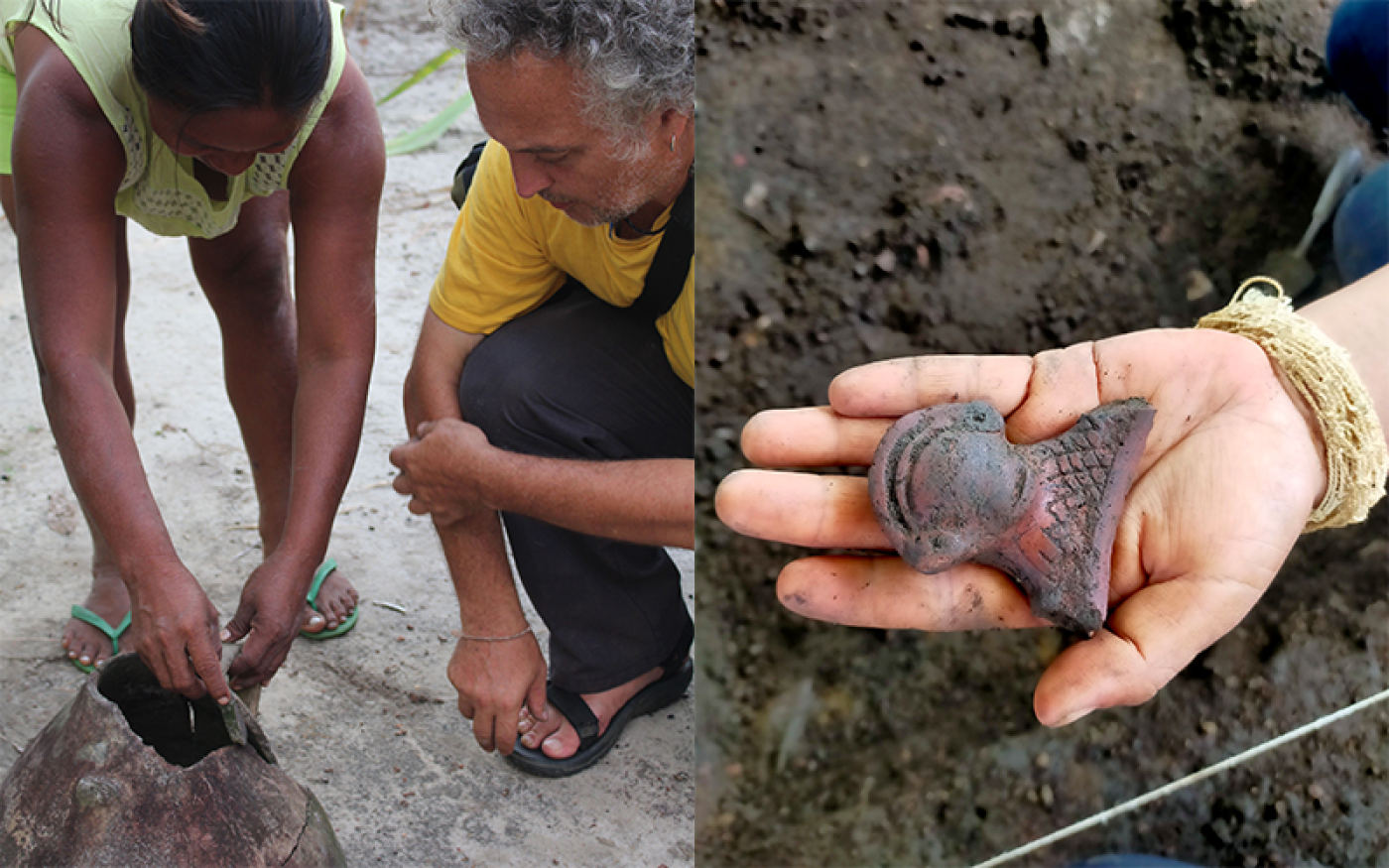
Left: An indigenous ceramic specialist from Taraquá shows Dr Manuel Arroyo-Kalin wares from the Amazonian rubber boom era. Right: A decorated pre-colonial adorno found at the time of excavation.

São Gabriel da Cachoeira, on the banks of the north-west Amazon, is considered Brazil's most Indigenous town
Dr Arroyo-Kalin is Associate Professor in Geoarchaeology at UCL Institute of Archaeology, where his research focuses on the Amazon. He has spent 24 years working in Brazil, Peru, Ecuador and Colombia, including nearly a year spent living with local communities on the upper Rio Negro.
His expertise is in soils and geoarchaeology, having studied the phenomenon of the Amazon’s anthropogenic ‘dark’ earths: patches of rich soils formed where pre-colonial settlements were located, in time becoming expanses of fertile ground.
Dr Arroyo-Kalin explained: “The site is dominated by black soil – or dark earth. In the context of the broader cultural history of Amazonia, you begin to see the formation of these when people became more fixed and adopted sedentary life. The north-west Amazon has always been seen as a nutrient-poor region, implying past populations would have been small and hence no dark earth would have formed; we are finding evidence of the opposite.”
Pre-colonial indigenous people in the Amazon basin would change the nature of soils by discarding, burning, and/or composting charcoal, ash, bone, vegetable refuse and pottery shards around their communities. Over generations, the ground was transformed into a rich, fertile soil that could sustain crop cultivation.
Peeling back layer after layer
By studying ancient objects uncovered with the archaeology students during excavations in 2019 and 2022, plus drawings, photographs, testimonials, and documents relating to people who lived in the area during several periods, the team gained a detailed picture of daily life hundreds and even thousands of years ago.
The team painstakingly peeled back layer after layer of soil to reveal the remains hidden beneath – pottery, charred plant remains, stone artefacts, and the dark earth itself.
Dr Arroyo-Kalin said: “We work with local descendent communities showcasing what lies beneath their feet. It is unique because we are working with the first generation of indigenous archaeologists that have been trained in this region.
“Our second excavation was at the plaza associated with the main church that the Catholic missionaries built in the early 20th century in São Gabriel da Cachoeira. Inhabitants of the city became very interested in finding out more about a place that they’d walked past their entire life. Records from the 16th century refer to the northern half of the Amazon basin as where El Dorado was located, and we had lots of people stop and joke ‘Are you looking for gold?’”
PARINÃ was recently featured in a US TV film "Ancient Builders of the Amazon," directed by Graham Townsley. One of the students who took part, Ana Keila Fontes Da Silva, said: “I want to get involved with archaeology. And I do it so I can learn the story of my people. These days, my people are interested in reclaiming the history of our indigenous Tariana community, learning how we got from the past to where we are now and into the future.”
The exhibition was hosted at the Knowledge Longhouse of the local indigenous political federation, FOIRN - which held a special significance.
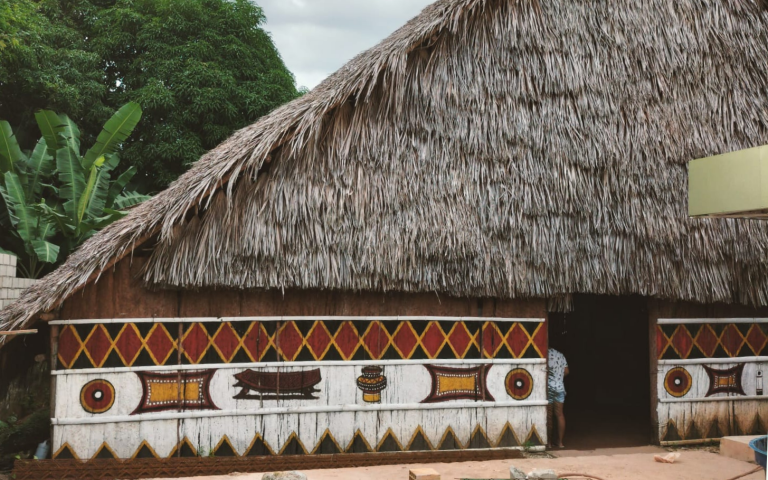
The 'Memories of Ancestral Landscapes' exhibition took place in the Knowledge Longhouse of indigenous organisation FOIRN
Dr Arroyo-Kalin explained: “FOIRN was the organisation that led the indigenous struggle to demarcate this land. It is an important organisation that symbolises the resilience of the indigenous movement in the region. Our excavations were the first investigations into the past of São Gabriel da Cachoeira and we presented them in these core and symbolically-charged premises. This was a highly emblematic gesture in terms of making heritage in the context of the indigenous movement.”
The work leading to the exhibition had its share of challenges, not least the Covid-19 pandemic. At one point, when bad weather delayed their plane, the team opted to spend four days travelling along the river by boat carrying artefacts that would be displayed.
Dr Arroyo-Kalin said: “Some of the most interesting sources of information of the beginning of the colonial period are the records of travel along the Rio Negro. For instance, the chronicle of Alexandre Barbosa Rodrigues refers to villages and locales, some still inhabited and others abandoned, that we cruised by on our 800km ascent to São Gabriel da Cachoeira. It gave us an opportunity to examine the bigger riverscape that we spend so much time thinking about. A view on Google Earth is very different from slowly making your way along the maze of canals and rivers.”
Returning results to communities
Materials were translated into three different Amazonian indigenous languages (Tukano, Baniwa and Nheengatú) to be handed out at the exhibition.
Dr Arroyo-Kalin said: “It was important for us to return to local communities a good account of the results of the project. One of the big complaints communities have is that they see generations of researchers coming in – anthropologists, biologists, ecologists, etc. – and the consistent theme is that they do their research and never return anything back. We have tried to build the opposite into our research programme, developing ways to work with local people and putting on an exhibition early in the process. We wanted to show people the results of our research within months rather than years down the line.”
As well as working with the student archaeologists, the team held workshops with indigenous ‘connoisseurs’ – shamans and elderly people – about what cultural heritage means to them.
Dr Arroyo-Kalin said: “We spoke to them regarding their understanding of the cultural history of the landscape, defining cultural heritage, what the sacred places are and why we need to look after them. It was very much intercultural – involving academically-trained researchers and indigenous people, in recognition that these were two complementary bodies of knowledge.”
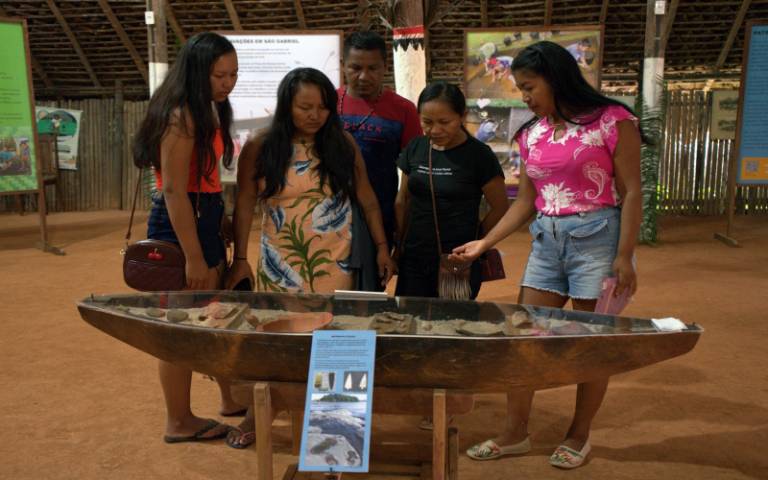
Archaeology students provide context for visitors to the 'Memories of Ancestral Landscapes' exhibition in São Gabriel da Cachoeira, Amazonas, Brazil
The scale of destruction brought about by the conquest, where European diseases and violence by settlers wiped out about 80% of the indigenous population within as little as 100 years, gave the excavation of the land a heightened relevance to the students involved.
Student archaeologist Odanilde Freitas said: “There has been a big impact on our culture of the centuries of colonisation, but with archaeology, I feel we can rescue and reconstruct our identity, our indigenous history, through artefacts like this. My people suffered, they disappeared. Imagine how they were massacred. For me it is very sad."
The exhibition attracted more than 100 visitors, including a performance by a local indigenous artist Rose Waikon and discussion with indigenous connoisseurs and leaders.
Dr Arroyo-Kalin said: “The exhibition showed the relevance of archaeology when plugged into the priorities of the indigenous movement and led to a research project in a political space.
“The biggest thing I have learned has been the importance of this history to the people themselves. There was an emotional relevance – students really felt emotional about what we were doing.
“Also, our understanding of the landscape and the way people transcribe their history onto it – it teaches you about how people live in place. So people might tell you, there’s a stone around the river bend where ‘xxx’ happened. It’s about how people historicise the place. We realised there are stores of knowledge within people’s existence.”
The PARINÃ team working with Manuel are: Helena Pinto Lima, Márcio Meira, Lucia Hussak van Velthem (MPEG); Filippo Stampanoni Bassi, Meliam Gaspar, Iberê Martins (Musa); Geraldo Andrello, Diego R Pedroso, Aline Scolfaro (UFSCar); and Alosio Cabalzar, Renata Alves (ISA).
Links
- Dr Manuel Arroyo-Kalin’s academic profile
- UCL Institute of Archaeology
- About PARINÃ
- UCL Faculty of Social & Historical Sciences
- UCL and Latin America
- Museu da Amazônia
- Museu Paraense Emílio Goeldi
- São Carlos Federal University
- Instituto Socioambiental
Image
- All images courtesy of Dr Manuel Arroyo-Kalin except where stated.
- Main image: Credit Moises Baniwa.
- Third image, left: Credit Helena P Lima.
Media contact
Sophie Vinter
Tel: +44 (0)20 3108 7787
Email: s.vinter [at] ucl.ac.uk
 Close
Close

